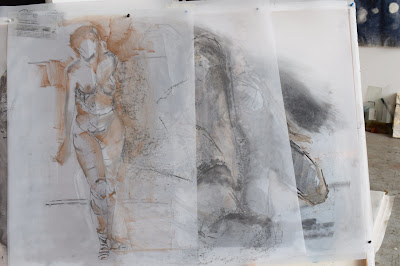Outpost 221223
Drawings re-examine, explore the 'Body Boundary' its feelings between the world of the individual and the world. Drawings attempt to establish a common boundary condition between themselves and the outside world.
We experience architecture not by aggressively seeking it, but by dwelling in it.
Drawing is always a formulation or elaboration of the thought itself at the very moment it translates itself, makes itself as an image.
Proximities and The Sensing Self.
You see and hear things figuratively and at a distance. But you touch the actual thing. You can extend haptic perception with an instrument, in which case the 'feeling/sensing' moves out to the end of the cane. But when you extend sight or sound, telescopically or electronically you continue to see and hear figuratively and at a distance.
Kinaesthesia a property of haptic sensing that allows one to sense the body motion (haptically) by detecting the movement of joints and muscles through your entire bodyscape. No other 'sense' deals as directly with the three dimensional world or similarly carries with it the possibility of altering the environment in the process of perceiving it. No other sense engages in feeling and doing simultaneously. This action/reaction characteristic of haptic perception separates it from all other forms of sensing, which in comparison come to seem rather abstract.
Body, Memory, and Architecture.
Bloomer, Moore.
Organism-Person-Environment
Affect Architecture : Sociological Inquiry.
Architectural Body.
Awakawa/Gins.
Caloricity/Corporeality.
The Dreaming Physical Body.
Poetry as a synthesis of human existence.
Novalis, Bachelard.
I've always loved encountering a Rothko, up close, they really hum through your body.
I like the spaces that a large scale offers.
I think of each mark or area as having the possibility of carrying a sensation.
Jenny Saville.
Bodily Boundaries.
Body-Image-Theory.
The 'Physical' Body is the private property of the individual, but the individual's Body Image is developed, socially and thus has a social property. The tendency to associate the body with physicality rather than image over associates the body with notions of privacy.
Bloomer, Moore.
Paint/Haptic Fleshings.
The Bodies She Paints.
Chadwick/Saville.
If Painting presents Being, the drawn line presents Becoming.
Norman Bryson.
Drawing : Bodily Transactions/Making Public.
Displaying : Showing Possession.
Possession, like a body is a feeling that calls on all the senses, but is the direct consequence of feelings that are confirmed haptically, in contrast to the more distant and figurative feeling that are experienced visually and audially.
Bloomer, Moore.
Drawing/Sensing Haptic Relations.
Situatedness through drawing produces the hapticity of the experience of seeing/sensing/feeling with the body.
The Anatomy of The Body.
The Exposed Interior of a Painting.
The Space between Abstraction and Figuration.
Having flesh as a central subject (what it feels) I can channel a lot of ideas.
I need my marks to construct the anatomy of the Body.
If there's a narrative I want it in the flesh, in the body of painting.
I try to find Bodies that manifest in their flesh something of our contemporary age.
I find having the framework of a body essential.
Jenny Saville.
Elpis. Gagosian Gallery. 2021
The monumental paintings explore the human body and its fascinating aesthetic potential. Saville's bold and sensuous impressions of surface, line, and mass oscillate between rational and irrational forms, capturing a unique approach to realism specific to the twenty-first century. The publication documents the twelve paintings in the exhibition alongside photographs of the artist's studio and reference materials, including snapshots taken by Saville. It also features a poem by Anna Akhmatova, whose work Saville learned about while she was in Russia, where she photographed many of the models pictured in the paintings.
.jpg)


.jpg)



.jpg)
No comments:
Post a Comment